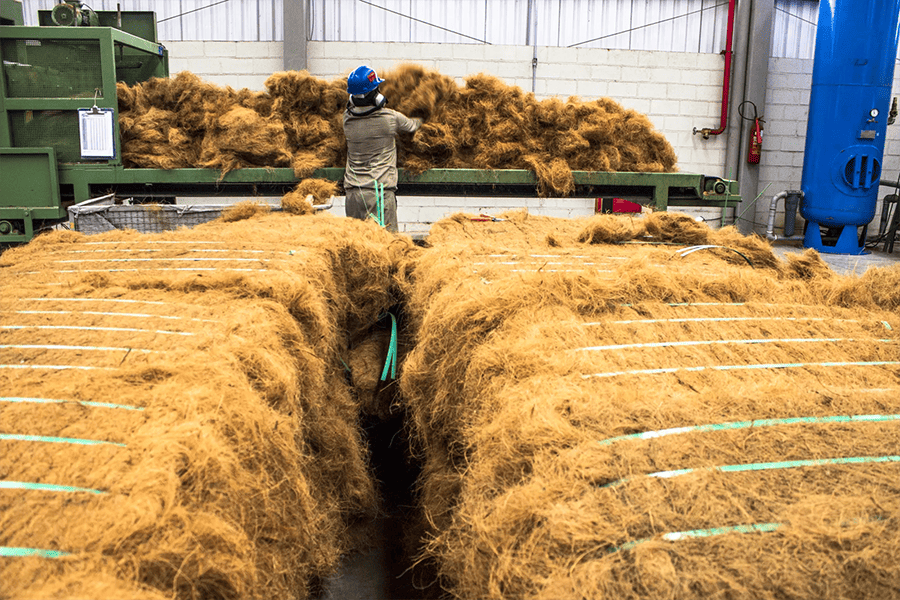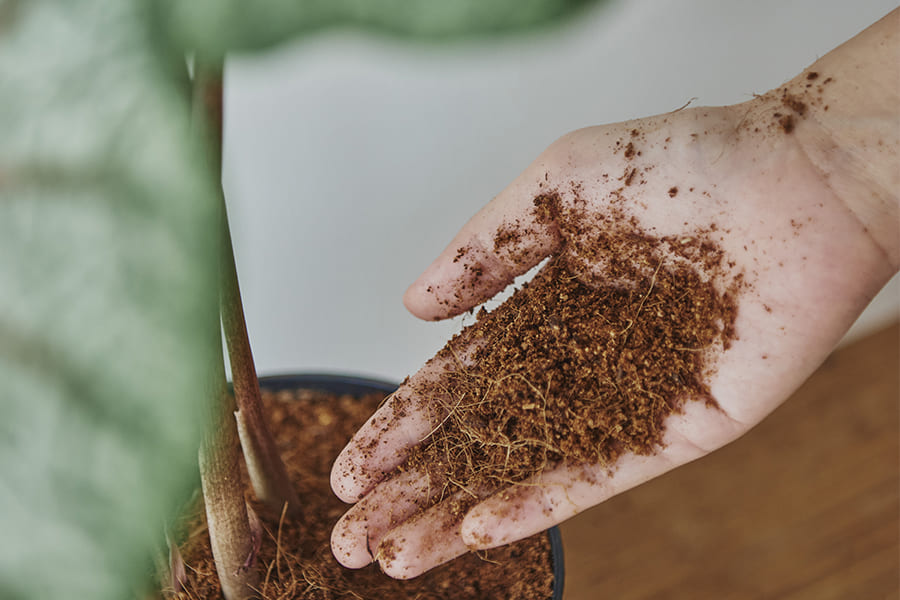BLOG POSTS & ARTICLES
Guide to Choosing the Best Coco Coir for Your Mushroom Cultivation

Mushroom cultivation is a delicate process that heavily relies on the selection of the right substrate. The substrate serves as the medium through which mushroom mycelium grows, and ultimately, fruiting bodies develop. The choice of substrate greatly influences the yield, quality, and overall success of mushroom cultivation. Different mushroom species have varying substrate requirements, and even within the same species, factors like strain and environmental conditions can affect which substrate is ideal. It's crucial to understand the specific needs of the mushroom species you intend to grow and select a substrate that meets those requirements. This involves considering factors like moisture content, pH, nutrient content, and the overall structure of the substrate.
Coco coir is valued for its exceptional water retention capacity, which ensures a consistent moisture level for mushroom growth. It also has good air porosity, allowing for adequate aeration of the substrate. Unlike traditional soil, coco coir is resistant to compaction, and it is free from pathogens and seeds, making it a safe choice for mushroom cultivation. As a sustainable and renewable resource, coco coir is an environmentally friendly alternative to other substrates.
Coco coir is made from the brown and white fibers found between the hard internal shell and the outer coat of a coconut. It is processed into various forms, including coir pith (or coco peat), coir fiber, and coir chips. In the context of mushroom cultivation, coco coir is commonly used as a substrate or growing medium to provide the necessary environment for the mushroom mycelium to colonize and produce fruiting bodies.
Advantages of using coco coir as a mushroom substrate
High Water Retention: Coco coir has excellent water-holding capacity, which is crucial for maintaining the required moisture levels in your mushroom substrate. This ability helps create a consistent environment for mycelium growth and mushroom development.
Natural and Sustainable: Coco coir is a natural and renewable resource, as it is derived from the husk of coconuts. It's an eco-friendly choice for substrate material, making it a sustainable option for mushroom cultivation.
pH Neutrality: Coco coir typically has a near-neutral pH level, which is ideal for many mushroom species. It reduces the need for pH adjustments and simplifies the cultivation process, particularly for beginners.
Low Nutrient Content: Coco coir is low in nutrients, which can be an advantage in mushroom cultivation. Mushroom mycelium and fruiting bodies rely more on the nutrients provided by supplements like grain spawn or compost. This allows for better control over the nutrient content of your substrate.
Resistance to Contaminants: Coco coir is naturally resistant to certain contaminants that can harm mushroom cultures. This resistance can help prevent contamination issues during the cultivation process.
Improved Aeration: Coco coir has good aeration properties, ensuring that the substrate remains well-aerated. Adequate oxygen levels are essential for mycelial growth and mushroom development.
Ease of Use: Coco coir is relatively easy to work with, making it suitable for both novice and experienced mushroom cultivators. Its consistent texture and moisture retention properties simplify the cultivation process.
Factors to Consider When Choosing Coco Coir
Moisture Content: Adequate moisture is crucial for mycelium growth. Coco coir should be damp but not excessively wet to suit your mushroom species' requirements.
pH Level: Mushrooms prefer a slightly acidic to neutral pH. Test and adjust the pH as needed or buy pre-buffered coco coir.
Pre-Treatment and Processing: Ensure coco coir is sterilized or pasteurized to eliminate contaminants. Store it in a clean, dry place to prevent contamination.
Different Mushroom Types and Cultivation Tips
Oyster Mushrooms (Pleurotus spp.):
Coco Coir Preparation: Oyster mushrooms thrive on coco coir with a moisture content of around 70-75%. Soak the coir, drain it well, and pasteurize it.
Temperature: Oysters prefer temperatures around 75-85°F (24-29°C).
Fruiting Conditions: Maintain high humidity (90-95%) and provide indirect light. Oysters are known for their fast growth.
Shiitake Mushrooms (Lentinula edodes):
Coco Coir Preparation: Shiitake mushrooms grow well on a substrate with a moisture content of 60-65%. Pasteurize your coir thoroughly.
Temperature: Shiitakes prefer slightly cooler temperatures, around 55-75°F (13-24°C).
Fruiting Conditions: Keep humidity around 85-90% and provide fresh air exchange.
Lion’s Mane Mushrooms (Hericium erinaceus):
Coco Coir Preparation: Lion's Mane prefers a moisture content of 75-80%. Hydrate and pasteurize your coco coir.
Temperature: They thrive in a cooler environment, around 65-75°F (18-24°C).
Fruiting Conditions: Maintain humidity levels between 90-95% and adequate fresh air exchange.
Reishi Mushrooms (Ganoderma lucidum):
Coco Coir Preparation: Reishi grows on a substrate with 70-75% moisture content. Ensure proper pasteurization.
Temperature: Reishi prefers temperatures between 75-80°F (24-27°C).
Fruiting Conditions: Maintain high humidity (90-95%) and indirect light. Reishi has a longer cultivation cycle.
Button Mushrooms (Agaricus bisporus):
Coco Coir Preparation: Button mushrooms grow best in coir with a moisture content of 65-70%. Proper pasteurization is essential.
Temperature: Keep the temperature around 75-80°F (24-27°C).
Fruiting Conditions: Button mushrooms require lower humidity (85-90%) and benefit from ventilation.
Enoki Mushrooms (Flammulina velutipes):
Coco Coir Preparation: Enoki mushrooms prefer a substrate with 70-75% moisture content. Pasteurize the coir thoroughly.
Temperature: They thrive in cooler conditions, around 45-55°F (7-13°C).
Fruiting Conditions: Maintain high humidity (90-95%) and provide ample fresh air.
Preparing Coco Coir for Mushroom Cultivation
Acquiring Coco Coir: Start with high-quality coco coir, preferably sterilized, and break it apart if it's in a brick or block form.
Hydrating Coco Coir: a. Place coco coir in a clean container.
b. Add hot water (160-180°F or 70-82°C) to cover the coco coir.
c. Let it absorb water for several hours or overnight.
d. Drain excess water, ensuring it's moist but not dripping wet.
Fluffing and Breaking Apart: Separate and fluff the hydrated coco coir to promote aeration and create a loose structure.
Sterilization or Pasteurization: Depending on your mushroom species and method:
a. Sterilize for complete microorganism eradication.
b. Pasteurize to reduce harmful microorganisms while preserving beneficial ones.
Mixing with Additives (If Necessary):
a. Vermiculite: Enhances moisture retention and aeration.
b. Perlite: Improves aeration to prevent compaction.
c. Gypsum: Provides calcium and pH regulation.
d. Coffee Grounds: Adds nutrients and regulates moisture for specific species.
Ensuring Proper Hydration and Conditioning: a. Maintain proper moisture level, like a damp sponge with no excess water.
b. Allow the substrate to condition for a few days to stabilize the environment.
Sourcing Coco Coir
When it comes to sourcing coco coir for your mushroom cultivation, it's essential to make informed choices, and this applies to the specific company or supplier you decide to purchase from.
Plantbest stands out as a reliable and reputable supplier that offers convenience with a strong reputation, quality assurance, and a commitment to customer satisfaction, Plantbest Coco Coir is an excellent choice for your substrate needs.
-
Plantbest ensures a steady supply throughout the year.
-
Plantbest provides a user-friendly online platform, making it easy to browse, select, and order products with swift and reliable delivery.
-
Plantbest offers complete transparency in product descriptions and specifications, allowing customers to make informed choices.
-
Plantbest Coco Coir offers exceptional customer support to address any questions or concerns, ensuring a smooth purchasing experience.
Common Issues in Mushroom Cultivation and Solutions
Mushroom cultivation can be a rewarding endeavor, but it's not without its challenges. As a supplier of Coco Coir, at Plantbest we understand the importance of helping you achieve optimal results. We have address common issues that growers encounter when using our coco coir as a substrate and offer practical solutions to ensure a successful mushroom cultivation journey.
Contaminants:
Problem: Contaminants in coco coir can hinder mushroom growth.
Solution: Ensure that you purchase sterilized or pasteurized coco coir from trusted sources like Plantbest. Sterilized coco coir minimizes the risk of contamination.
Inconsistent Moisture Levels:
Problem: Inadequate or excess moisture can lead to stunted mushroom growth.
Solution: Hydrate your coco coir properly before use, following our guidelines. Maintaining the right moisture level is essential for successful mushroom growth.
pH Imbalance:
Problem: Coco coir may have an unsuitable pH level for mushroom cultivation.
Solution: Test the pH of your coco coir and adjust it as needed with appropriate amendments. Plantbest Coco Coir is known for its neutral pH, which is ideal for many mushroom species.
Poor Aeration:
Problem: Inadequate air exchange can lead to mould growth and hinder mycelium development.
Solution: Consider mixing coco coir with vermiculite or perlite to enhance aeration and promote mycelium growth.
Insufficient Nutrients:
Problem: Coco coir alone may lack essential nutrients for mushroom growth.
Solution: Supplement your coco coir with nutritious additives, such as gypsum, to provide the required nutrients for your mushroom species.
Temperature Fluctuations:
Problem: Inconsistent temperatures can affect mushroom fruiting and development.
Solution: Maintain a steady temperature range suitable for your specific mushroom strain. Use a temperature-controlled environment or insulate your growing area to prevent fluctuations.
Contaminated Spore Prints:
Problem: Using contaminated spore prints can introduce unwanted pathogens.
Solution: Ensure the quality of your spore prints and follow proper sterilisation procedures when inoculating your substrate.
Overcrowding:
Problem: Overcrowded growing conditions can impede mushroom growth and lead to disease.
Solution: Space your substrate and maintain proper airflow to prevent overcrowding.
Happy cultivation! If you have any questions or need further assistance, please don't hesitate to reach out to us. We're here to help with any inquiries you may have. Happy growing!











__(3).jpg)









